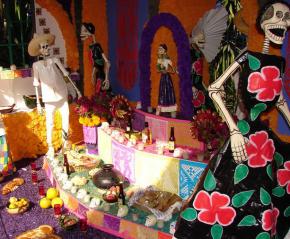Walking with the dead
reviews an exhibit organized around the theme of the "Day of the Dead" at Chicago's National Museum of Mexican Art.
THE MEXICAN holiday, El Día de Los Muertos, or the Day of the Dead, is as much about the living as it is about the dead.
The memory of the dearly departed is kept alive by the creation of ofrendas (altars). They are artistic expressions that allow their creators to celebrate and commemorate a person's life the way that they want to. For those who didn't know the deceased, an ofrenda is an opportunity to get to know them.
There is a democracy in the art of creating an ofrenda: Anyone can make one--no art degree required, just a desire to remember someone by putting together objects of your choosing. The best ones excavate and explore the life and death of a loved one through combining disparate objects, food, drink, jewelry, chotchkies, music, videos, photos, poetry, painting and sculpture. They ache with the spirit of the dead.
The Day of the Dead exhibit at the National Museum of Mexican Art (NMMA) in Chicago has ofrendas that range from stunning, to profoundly heartbreaking, to weird and whimsical. There are calaveras (skulls) everywhere--some made of sugar and ready to eat.

The galleries have been transformed into temporary funeral homes, and the mood is upbeat, even humorous--not scary at all. In Mexican culture, El Día de Los Muertos is about reuniting with the dead in a spirit of love, remembrance and mourning. In addition to creating altars, families spend the day picnicking in the cemetery at the gravestones of their loved ones.
Ofrendas are often overtly political because of the racism experienced by millions of undocumented and documented immigrants in the U.S. There is a political dimension to how and why some immigrants die.
One of the most in-your-face altars on display is titled "The Death of a Dream." It alludes to the Dream Act, legislation that would have allowed undocumented young people to become citizens that was never enacted. On each side of the ofrenda is a tall, wobbly stack of books, and perched on top are two rulers fastened together in the shape of crosses. Strung between the stacks of books is string from which hang diplomas.
There are skulls and apples on desks. Flowers litter the floor. On the altar is the declaration, "The dreams of 65,000 immigrant students die every year. Education is a human right. Dream Act Now!"
Marcos Raya is an internationally famous painter who lives in Pilsen, a Mexican-American neighborhood in Chicago that is home to the NMMA. His dark and dangerous ofrenda is titled, "The Devil and Death in the Alley." A painting shows angry, alienated, intoxicated people falling down and caught off balance. A man is swinging a machete.
Under the painting is a shelf with painted skulls. Some have shiny glass objects glued on them; others have metal components from inside computers. There are two outstretched glass hands--one holds syringes and the other white powder. Drugs and the damned is the message.
Raya dedicates his installation "To the people that die in the streets, addicts, the homeless, vagabonds, good-for-nothings, sons of the rotten life, the dispossessed and the lost souls."
ONE OF the most haunting ofrendas is by John Salhus, called "Ride Me Home." It's dedicated to bicyclists hit or killed on the street. Every part of the altar is spray-painted either black or white: vases of flowers, a six-pack of beer, a bicycle. Hanging above the altar are mobiles with dozens of floating, white bicycles. The air twirls them around slowly, casting eerie shadows on the canvas backdrop. They're "ghost bikes."
Pablo Serrano created a mixed media ofrenda titled "Liberty Virgin Mary." In the center is a coffin-like Statue of Liberty, but in place of her face is a video screen flashing the faces of dozens of immigrants. The statue stands on a dirt grave that symbolizes the desert where thousands of immigrants have perished trying to enter the U.S.
On the ground are flowers and a gallon jug of water. Serrano explains, "This ofrenda memorializes the cultural sacrifices undocumented immigrants make when they become part of the United States."
The ofrenda that leaves the viewer dazed and disbelieving is dedicated to the 49 children who died in a fire at a day care center in Sonora, Mexico, in June of this year. There is a red heart-shaped pillow with a picture of a nun pinned to it. She is crying tears of pearls on strings that pool in a glass below.
Framing the altar are 49 pictures of the victims. On the floor lay stuffed animals, teddy bears, action figures and toys that the dead children will never play with. There are skulls framed in purple and gold lamé boxes, angel wings and candles. This ofrenda is grounded in staggering grief.
The exhibit El Día de Los Muertos takes the subject of death and raises it to a high level of art--full of beauty, powerful emotions and ideas that stay with the viewer long after they've left the museum. The living must remember the dead.
Check out the exhibit across the hall, too: Women of Juárez: Rastros y Crónicas. It's a small, stunner of a show featuring artwork that depicts the disappearances and murders of more than 500 women in Ciudad Juárez, Mexico.


